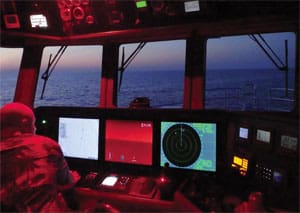Nighttime voyaging in the pilothouse of a trawler gives you a front-row seat to another world. Everything that is so obvious and familiar during the daytime changes dramatically when the sun goes down and your visual orientation is compromised.
Yes, it feels different, but it’s really not. Many of us believe an overnight passage is safer because we are intuitively more cautious, strategically more conservative and mentally more attentive. Before taking off to experience the dark side between dusk and dawn, here are a few suggestions to dial-in your trawler.
Visibility is paramount; you must be able to see and — just as important — you must be seen. In darkness, your pupils dilate and become very sensitive to light, and your depth perception is hindered. A dark pilothouse makes it easier for you to look out to see the outside world. Interior lights must be turned off and electronics sources must be tamed by reducing brilliance on navigation screens (as well as panels for engines, stabilizers, watermakers and all other control heads). Dimming the brightness on every display, as well as muting sounds, is something you need to know how to do before you depart. I like to bring along a sheet of thin red plastic (think: school report binder) and a roll of blue tape to utilize as light blockers when the built-in features for lumens can’t be changed. It can take 30 minutes or longer to re-establish your night vision, so be careful and keep this in mind. Never shine a light at an approaching ship.
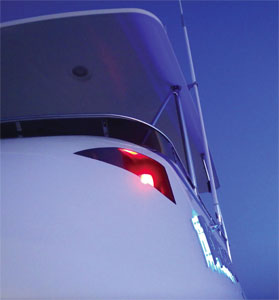 |
|
Make sure your running lights are working so other vessels can see you. |
Red lighting
Red lights in the overhead help you see and are ideally placed in the pilothouse, galley and heads — areas you will frequent at night — in addition to floor courtesy lights at stairways. Household night-lights can be plugged in to outlets in common areas to assist with spatial orientation and make it safer for moving about when the white lights are turned off.
You must insure that your running lights are working and I strongly recommend upgrading to LED for long-lasting reliability, as changing out bulbs at sea is a hassle. Before you leave the dock you should inspect all key lights — red port, green starboard, white forward steaming and white stern light — as well as your anchor light. If you get glare on your bow pulpit from the steaming light, consider adding a deflector “plank” just beneath it.
Night operations should be planned out well in advance. With a trawler you have a good idea of your speed and can estimate how long it will take you to complete your trip by plotting your course with waypoints to arrive on schedule with reasonable accuracy. You should lay down a series of waypoints on your plotter and copy them over in pencil onto a paper chart. You want to calculate the time to arrive at your destination during daylight. This may mean a night departure depending upon the distance, weather, etc.
Before you take off, make sure you are ready to stop. You may need to anchor if you arrive early or if something happens, so clear off the canvas windlass cover and make sure you are ready to drop the hook. This simple preparation could save a lot of precious time if you get into a pinch during your trip. Don’t forget to look behind you when you depart, as you may need to retreat and you’ll feel more confident returning to a safe harbor if it looks familiar. Regular daylight can change the shape of landmarks and profiles get distorted by the silhouettes that darkness brings.
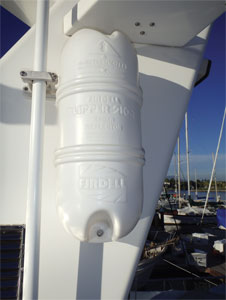 |
|
A radar reflector and AIS are the electronic equivalent of running lights. |
Radar is very helpful for identifying targets, other boats and buoys, but you also need to look for lights ashore and other objects. It can become confusing if there is a boat between you and land, as their running lights can get absorbed by the shore lights and blend in, making them difficult to differentiate. Tracking radar targets to determine their course, speed and time to closest approach is essential. Binoculars can help you “zoom in” to cross-reference what your electronics are telling you. You really need to trust your nav/comm and be careful not to second-guess technological input; it is easy for your eyes to play tricks on you at night.
Your trawler will most likely be “seen” by radar first, well before another boater will eyeball your running lights, so it’s important to have a strong signature. Installing a radar reflector will help you stand out and give you some peace of mind.
Use your VHF
When in range, I like to hail another boat at night to make sure my VHF is transmitting and to let them know I can see them and ask them how well I’m depicted. Don’t assume they see you just because you see them. AIS will let you hail another ship by name in addition to telling you their size, course and speed. As you converge you can also ask to verify light displays. Be communicative and conservative with all crossing situations.
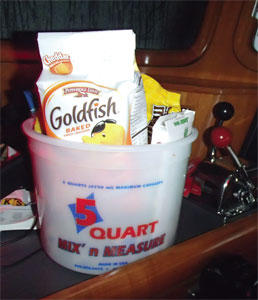 |
|
Jeff Merrill likes to have a “cookie bucket” nearby so the watchstander can stay alert with a snack. |
Staying awake at night shouldn’t be an issue if you have a posted watch schedule and a defined routine. Most nighttime watches are solo, which is nice because there are fewer distractions, but it does put a stronger demand on competence as you will need to make smart decisions. While on watch you need to rely on your ship’s electronics for feedback. It’s very difficult to scan the water in front of you for debris (something you almost take for granted during the day), so many trawlers run more slowly in the dark, which gives the skipper more time to respond and will result in a softer impact if things go bump in the night. Forward-looking sonar or a FLIR night vision package are two nice luxuries to minimize this concern. An egg timer or more sophisticated Watch Commander, reset every 15 minutes, can remind you to make a 360 degree visual sweep of your outside surroundings and reconfirm that your engine and operational instruments have normal readings.
A cookie bucket
I like to have a “cookie bucket” within reach, a five-quart plastic tub that has bottled water and snacks inside and is low profile so it won’t spill over … and should you feel a little woozy, you have a convenient receptacle to “toss your cookies”. Since you are by yourself, everything you need should be easily within reach: flashlight with red and white lenses, binoculars, paper chart and pencil, ship’s log, tissues, trash bin, etc.
It’s a good idea to get out of the helm chair at least twice an hour to walk around a bit, work your arms and legs, get the blood circulating and stretch — after all, it is called “standing watch” and this will help keep you alert. I’ll usually break up each hour on watch by noting the GPS lat/long in the log and on the paper chart at the top of the hour, listening to VHF weather at the 30 and using the 15 and 45 for loosening up. I like to “look-out” or take a long view outside the boat each quarter hour, and, if appropriate, open a pilothouse door to see the stars and breathe some fresh air.
Engine room checks are more difficult at night when you are a solo skipper running the boat, monitoring the electronics and machinery — you really can’t leave your post for very long. I prefer to leave the engine room lights on, which is especially helpful if you have a closed circuit TV camera for a quick visual from the helm, but don’t let the CCTV replace a proper ER check. It’s a nice game plan to do one ER check per watch at night, with the oncoming watch stander “warming up” by starting out in the ER to check valves, temperatures and the bilge.
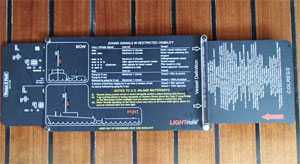 |
|
For those power voyagers rusty on their rules of the road knowledge, memory aids like the Weems & Plath LightRule can help in identifying other vessels at night. |
Some other things to consider that will make your night passages safer and less stressful include:
• RainX — Or an equivalent glass coating on your pilothouse windscreen to bead up water.
• Compass light — Make sure you can see your magnetic compass heading. I also like to have a Post-It pad and write down my heading for quick reference, so if I have to change course I have a quick reminder of what I was steering.
• Weems & Plath LightRule — This is a nice guide to quickly determine USCG Colregs light configurations on other ships. Keep it alongside your rules of the road book.
• Chart light — A good built-in adjustable “wand” with small focused red and white lights.
• LightWedge LED magnifier — This is a great way to view a chart at night without turning on other lights.
• Portable searchlight (large beam) — Make sure you don’t shine it directly at another boat.
• Stabilized binoculars — These can be very helpful in rough seas.
• Inflatable PFD harness — With whistle and strobe, to be worn by any crew who has to go outside. Crewmembers must have a compelling reason and must have another crew watch them until they are back safely inside.
• Ditch bag — Be ready to go and know where all of your USCG safety gear is located.
If you can schedule your first night passage with a half moon or fuller, you will have a better defined horizon and get comfortable moving about in the dark. Night typically finds less ship traffic at sea with more experienced operators at their helms and the further you venture from shore, the less floating debris you will encounter. Take your time moving around at night and be more deliberate with your footing and what you grab; a fall can really spoil your evening.
After you are underway and get settled, but before everyone breaks away to leave the first watch stander solo, make it a rule that everyone meets in the pilothouse if the RPMs change. This is the easiest way to communicate that the helmsman needs assistance. Sometimes slowing down or stopping will provide the time you need to reason through a sticky situation. Don’t be afraid to ask for another pair of eyes in a potentially tricky crossing situation — it’s better to be safe than sorry and the rest of the crew will rest easier if they know the person at the helm will ask for help if needed.
Jeff Merrill, CPYB, is the president of Jeff Merrill Yacht Sales — www.JMYS.com. He is a veteran yacht broker who provides individual attention and worldwide professional representation to buyers and sellers of premium brand, oceangoing trawlers. Merrill is active in the cruising community as a public speaker and writer and enjoys spending time at sea with clients. Jeff has written several “Dialing-In” your trawler articles for Ocean Navigator and is constantly looking for new ideas to improve and simplify the trawler lifestyle. If you have a suggestion or want to get in touch please e-mail Merrill at: trawlerspecialist@gmail.com.

